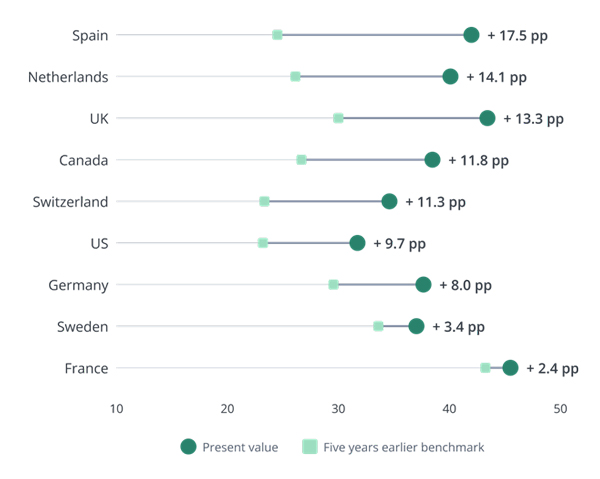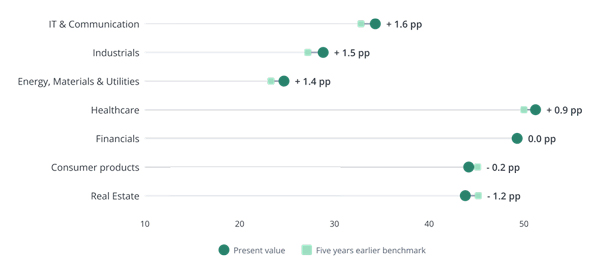On the occasion of International Women’s Day, Clarity AI, the leading global sustainability technology company, has unveiled the results of a new study analyzing gender parity among companies in the MSCI ACWI Index, which represents 85% of the world’s listed market capitalization. The study reveals that no company has achieved gender parity—meaning equal representation of men and women—across the workforce, management, board, and salary equity, despite some progress over the past five years. These findings highlight the pressing need for more ambitious actions towards gender equality in the workplace. They also come at a time when diversity policies are increasingly under scrutiny, with debates over their impact and effectiveness gaining traction in political and corporate spheres.
The data show that while 392 companies (15%) have achieved gender parity in their workforce, the numbers shrink dramatically when considering more senior levels of leadership. Only 136 companies (5%) have reached parity in workforce and managerial roles, and a mere 12 companies (0.5%) have attained parity across workforce, management, and board levels. Notably, no company has managed to close the gender salary gap while also maintaining parity across workforce, management, and board roles.
Percentage of MSCI ACWI Companies Achieving Gender Parity Across Key Levels

Based on the most recent available data for each company, primarily from 2023 or 2024. Source: Clarity AI. Data as of March 4, 2025.
Global Progress: Incremental but Insufficient
The research highlights that, although there has been slow, but steady progress over the past five years, it remains far from enough. The most notable improvement has been in board parity. For the MSCI ACWI, considering the average across all companies, board representation increased by eight percentage points, rising from 19% to 27%. In Western economies—specifically countries in Europe and America with a high number of corporate headquarters—board representation rose from 26% to 36%, reflecting better performance in high-income regions.
However, when it comes to parity in the entire workforce the trend is different. Unlike board representation, workforce parity improved at a similar pace across both high-income countries and other regions, each achieving only a modest one percentage point improvement. Globally, workforce parity increased from 34% to 35%, while it rose from 37% to 38% in Europe and North America. Although the improvement in workforce parity figures has not significantly surged, it is worth acknowledging that workforce parity is generally higher than board diversity.
“We have been discussing gender parity for years, but we are still far from achieving full gender parity across workforce representation, management, board positions and salary equity”, said Patricia Pina, Head of Product Research and Innovation at Clarity AI. “While gender is just one dimension of diversity, it is a critical one that influences representation at all levels and directly impacts business success. Diverse teams bring a wealth of perspectives, experiences, and ideas that foster innovation, enhance decision-making, and drive better business outcomes. To unlock these benefits, companies, investors, and policymakers must work together to accelerate progress and implement effective measures to close these gaps.”
France Leads in Gender Parity Across Key Indicators
A closer look at geographical trends reveals that, on average, companies based in France are leading in gender parity. Women represent 42% of the workforce, occupy 39% of management positions, and hold 46% of board seats.
Meanwhile, Spain stands out for its rapid progress. Companies headquartered in Spain have increased female board representation by 18 percentage points over the last five years, achieving 42%—the most significant improvement among all countries analyzed.
Five-Year Trend of Female Board Representation by Country

The figure shows the average female board representation for each country, based on companies from the MSCI ACWI headquartered there. For the five-year analysis, data from 2019 and 2024 is used; if unavailable, data from 2018 and 2023 serves as the alternative basis. Gender parity is considered achieved when 50% female representation is reached. Source: Clarity AI. Data as of March 4, 2025.
This progress reflects the impact of legislative measures in some countries that mandate minimum female representation on boards. France's leadership in gender parity is bolstered by its 2011 policy requiring 40% female representation. In contrast, Sweden, without recent mandates, has seen less change but retains strong gender equality norms.
Health Care Sector: The Only One to Achieve Workforce Parity
Sectoral analysis reveals that the Health Care sector is the only one with average female workforce representation reaching parity, standing at 51%. It is followed by Financials (49%), Consumer Goods (45%), and Real Estate (44%) sectors, which are closer to achieving parity. Within these sectors, certain industries have already achieved workforce parity. In Financials, both Banks (50%) and Insurance (52%) have reached parity. Similarly, in Consumer Products, Consumer Retail has also achieved a balanced workforce at 52%.
In contrast, the Energy, Materials, Utilities, and Industrials sectors have the lowest female workforce representation, with each sector having approximately 25%, highlighting a significant gender gap in these industries.
Five-Year Trend of Female Employee Representation by Sector

The figure shows the average percentage of female employees for each sector, based on companies from the MSCI ACWI. For the five-year analysis, data from 2019 and 2024 is used; if unavailable, data from 2018 and 2023 serves as the alternative basis. Gender parity is considered achieved when 50% female representation is reached. Source: Clarity AI. Data as of March 4, 2025.
While gender parity shows incremental progress, significant gaps persist across industries and countries. Collaboration among companies, investors, and policymakers—supported by data-driven strategies—will be essential for driving meaningful change globally and tracking long-term progress.
For more information, please visit: https://clarity.ai/




